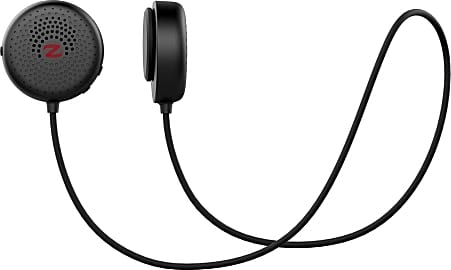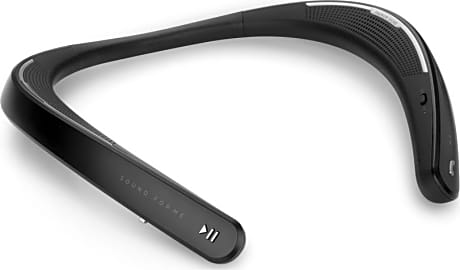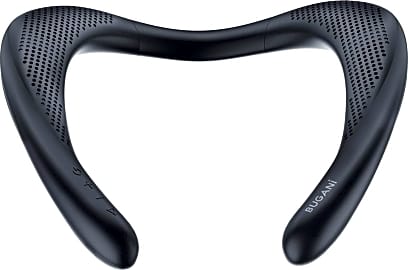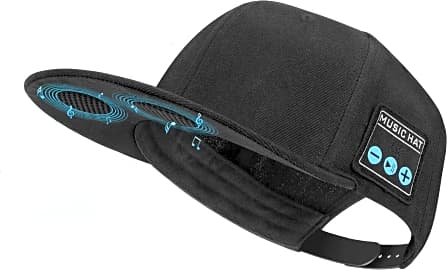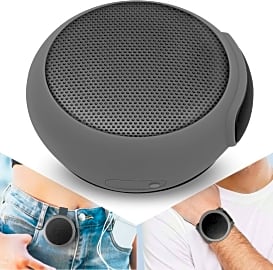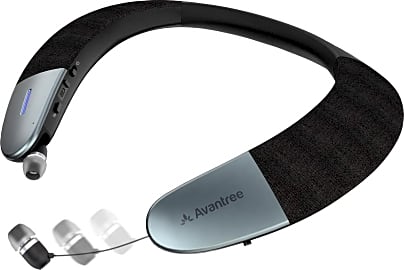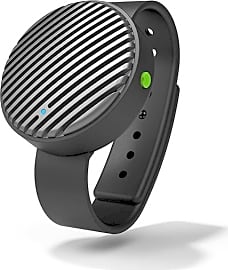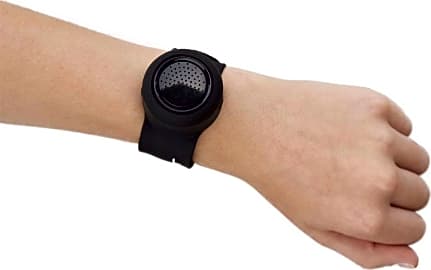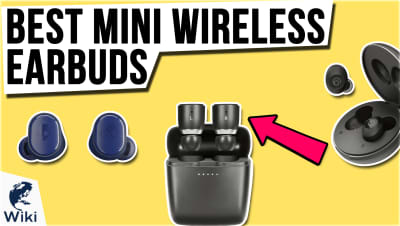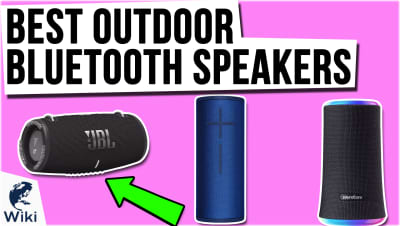The 10 Best Wearable Speakers

This wiki has been updated 31 times since it was first published in October of 2017. Whether you're riding your bike, jogging on a trail, or socializing with friends, one of these wearable speakers will let you take your tunes and podcasts with you. From watch-like options to devices that go around the neck, they are packed with useful features and the ability to reproduce decent sound quality from a wide variety of audio sources, including mobile phones. When users buy our independently chosen editorial choices, we may earn commissions to help fund the Wiki.
Editor's Notes
December 08, 2020:
Unlike headphones and earbuds, wearable speakers allow you to remain aware of your surroundings. They are ideal for individuals who need to listen to music to get them through the day. You can wear the device while doing chores, exercising at the gym, or taking a walk around the block.
This list offers a variety of options, including neckbands, wrist wearables, hats, and clips. But let’s first discuss why we eliminated a few of the previous picks. Users reported bugs with the TOKK Smart software. Namely, the keyboard disappeared on their phone when connected to the device. Also, some buyers felt the magnet was not strong enough to stay in place while exercising. Secondly, the Osten Design either stopped working after a couple of months or vibrated continuously even when turned off.
Since the JBL Soundgear cut out when you put your phone in your pocket or walked across the room, it was removed. Buyers also cited a disappointing battery life. We also excluded the Sony SRS-WS because users noted that it did not deliver the immersive experience one would expect from the brand. Finally, we removed the LG Tone Studio HBS-W120 due to availability concerns.
Instead, we added the Avantree Torus NB05 and the Bugani M115. Both devices sit comfortably on the shoulder blades. Not only does the Avantree Torus NB05 work with any Bluetooth-enabled device, but it also provides up to 48 hours of playtime when using the earbuds. Plus, you can easily switch from speaker mode to the earbuds when you need to take private calls. We like the sweat-resistant band on the Bugani M115. It's a perfect device for individuals who like to listen to music while working out.
Next, we added the ANCwear Portable Mini for its versatility. It comes with a variety of interchangeable accessories. You can wear it on the wrists or attach it to clothing. It also works as a standalone, so you can sit it by a pool without worrying about damage from splashing water. And although the Edyell Cap doesn’t have sweat-resistant properties, it a stylish option running errands and to complement casual wear.
October 09, 2018:
We were able to expand the list to include a few more products as more manufacturers bring high-quality wearables to the market. The Sony SRS-WS1 was added because it offers impressive audio and an immersive experience that includes vibrations. Since it uses a 2.4GHz connection to transmit its signal, it doesn't have the lag often experienced with Bluetooth. Of all the models we researched, the Bose Soundwear Companion offers the best sound, which shouldn't come as a surprise to anybody familiar with this company's products.
While around-the-neck models are often marketed for use while jogging, some users may find they bounce around too much, especially on people who run fast. For those people, we recommend either the Zulu Alpha, which is held in place via magnets, or the Tech-Life BoomBand, which straps onto your wrist just like a watch.
The Tokk Smart has continued to lose ground on the list because its low volume doesn't compete with some of the newer models, and it has somewhat finicky volume controls. Its overall value for money still earned it a place on the list, as it's a good budget choice for those listening in quiet environments.
Users who want the freedom to seamlessly switch between headphones and speakers will want to take a look at the LG Tone Studio HBS-W120 and Osten Design Bluenin BBH-930, which both feature built-in, corded headphones. Of these two, the LG Tone Studio HBS-W120 is definitely a higher-quality option.
Why Go With A Set Of Wearable Speakers?
There's a good chance that you already own a particular type of wearable technology that's designed to let you listen to music hands-free and on-the-go.
There's a good chance that you already own a particular type of wearable technology that's designed to let you listen to music hands-free and on-the-go. You might not think of it as wearable technology simply because it's been around for so long — since well before the current trend of wearables — but when you check the criteria for what qualifies as wearable tech, your regular old headphones certainly fit the bill.
Headphones adhere to a body part, allowing you to utilize them without necessarily having to use your hands, and they require little to no thought for you to transport them while wearing them. Add the fact that so many models on the market today connect to your music players wirelessly, and it becomes increasingly difficult to deny headphones their rightful place among wearable technologies.
Unfortunately, headphones aren't always the appropriate choice in a variety of situations. One of the things that most sets of headphones do reliably is cover up your ears. Even small ear buds are designed to isolate your listening experience as much as possible, as many consumers prefer the sound quality that this offers. But if you need your ears for anything from carrying on a simple conversation to staying aware of your environment, you may require something a little different.
Bone conduction headphones are one option, but some people find these a bit uncomfortable, and the technology is still a few years from being able to produce a high enough sound quality to convince most people to invest. You could also try to simply carry around a small Bluetooth speaker with you wherever you go, but this is liable to prove a cumbersome nuisance, and since you aren’t wearing your portable speaker on your body, there’s an increased chance that you’ll forget it somewhere. Perhaps a better option, then, would be to utilize a set of wearable speakers. These give you the ability to pump your favorite tunes and podcasts wherever you are, without obstructing your ears’ ability to hear what's going on around you.
Choosing The Right Wearable Speaker For You
Wearable speakers come in a handful of different shapes and sizes, giving the consumer a lot to think about before making a purchase. Given that this is a relatively new market category, some of their features might seem a little foreign to you, but with just a bit of understanding, you can pretty easily make a determination as to which style suits you best.
Wearable speakers come in a handful of different shapes and sizes, giving the consumer a lot to think about before making a purchase.
The majority of wearable speakers on the market are designed to fit around the user's neck. They don't wrap all the way around the neck, however. Rather, they sit along the back of the neck and just over either side where the neck meets the shoulders. It's on these sides that manufacturers install their speakers, as from here any sound eliminates straight upward and into your ears. This style is liable to offer you the widest range of available brand names, including many companies with excellent reputations in sound design. The downside to these, however, is that in particularly warm climates their presence on the back of your neck can cause a little extra sweating and discomfort.
Like any set of wearable speakers, the models designed to fit around your neck suffer from an inherent lack of privacy. Whatever you're listening to, at pretty much any volume, is going to be audible to anyone within earshot. As such, these devices are often inappropriate for taking phone calls, especially in public. Some of these designs, however, feature built-in earbuds with retractable cords that allow you to deactivate their primary speakers and use this more private channel instead.
While other options don't necessarily include this kind of privacy, they do offer alternatives to the comfort downsides presented by the around-the-neck models. Some available models are small and light enough to easily clip onto parts of your clothing, while others augment the around-the neck style with thin, light chords instead of bulky padded speaker units. Make sure to look for a style that's in line with your comfort in your current set of accessories. If you're not a fan of scarves or jackets with furry or padded collars, you may find some of the around-the-neck models to be to suffocating. On the other hand, these are liable to be the units that offer you the best sound quality, and if you know you're going to wear them mostly in controlled environments where you can regulate the ambient temperature to keep yourself from sweating, they might be your best choice.
A Brief History Of Wearable Tech
Wearable technology isn't really anything new. Technology, after all isn't exclusively electrical by nature; in truth, any advancement to the physical tools that we utilize as a species is an advancement in technology. It just so happens that most modern technological advancements happen in the electronics sector. That means that the first fig leaves that Adam and Eve used to cover their shameful nakedness were indeed the earliest example of wearable technology.
That history realistically began with the wrist watch, as prior to its explosion in use and popularity, most anyone with a timepiece kept it in their pocket.
Of course, by our more modern definition, wearable technology has a slightly shorter history. That history realistically began with the wrist watch, as prior to its explosion in use and popularity, most anyone with a timepiece kept it in their pocket.
Later, in the 20th century, video cameras became small enough to mount to the helmets of skiers and other sports enthusiasts. These were still heavy and bulky enough at the time to pose a significant danger to the athletes, but as the slew of GoPro selfies taken atop skyscrapers shows us, these extreme documentarians don't exactly put their safety first.
Google had a valiant attempt at incorporating wearable technology into our society back in 2013, and while their Glass units sit rotting in an undisclosed warehouse, today’s software has finally caught up to the point where augmented reality may create a new and profitable market for some type of glasses. This is even more likely given the perhaps unexpected popularity of smart watches, the charge into which was recently led by Apple, and which now includes some of the most prominent manufacturers in tech.


